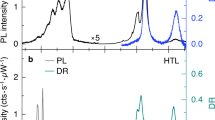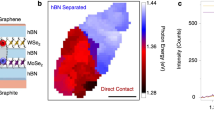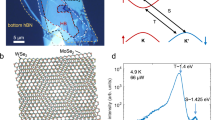Abstract
Transition metal dichalcogenide moiré bilayers with spatially periodic potentials have emerged as a highly tunable platform for studying both electronic1,2,3,4,5,6 and excitonic4,7,8,9,10,11,12,13 phenomena. The power of these systems lies in the combination of strong Coulomb interactions with the capability of controlling the charge number in a moiré potential trap. Electronically, exotic charge orders at both integer and fractional fillings have been discovered2,5. However, the impact of charging effects on excitons trapped in moiré potentials is poorly understood. Here, we report the observation of moiré trions and their doping-dependent photoluminescence polarization in H-stacked MoSe2/WSe2 heterobilayers. We find that as moiré traps are filled with either electrons or holes, new sets of interlayer exciton photoluminescence peaks with narrow linewidths emerge about 7 meV below the energy of the neutral moiré excitons. Circularly polarized photoluminescence reveals switching from co-circular to cross-circular polarizations as moiré excitons go from being negatively charged and neutral to positively charged. This switching results from the competition between valley-flip and spin-flip energy relaxation pathways of photo-excited electrons during interlayer trion formation. Our results offer a starting point for engineering both bosonic and fermionic many-body effects based on moiré excitons14.
This is a preview of subscription content, access via your institution
Access options
Access Nature and 54 other Nature Portfolio journals
Get Nature+, our best-value online-access subscription
$29.99 / 30 days
cancel any time
Subscribe to this journal
Receive 12 print issues and online access
$259.00 per year
only $21.58 per issue
Buy this article
- Purchase on Springer Link
- Instant access to full article PDF
Prices may be subject to local taxes which are calculated during checkout




Similar content being viewed by others
Data availability
Source data are provided with this paper. All other data that support the plots within this paper and other findings of this study are available from the corresponding authors upon reasonable request.
References
Shimazaki, Y. et al. Strongly correlated electrons and hybrid excitons in a moiré heterostructure. Nature 580, 472–477 (2020).
Regan, E. C. et al. Mott and generalized Wigner crystal states in WSe2/WS2 moiré superlattices. Nature 579, 359–363 (2020).
Tang, Y. et al. Simulation of Hubbard model physics in WSe2/WS2 moiré superlattices. Nature 579, 353–358 (2020).
Sung, J. et al. Broken mirror symmetry in excitonic response of reconstructed domains in twisted MoSe2/MoSe2 bilayers. Nat. Nanotechnol. 15, 750–754 (2020).
Xu, Y. et al. Correlated insulating states at fractional fillings of moiré superlattices. Nature 587, 214–218 (2020).
Wang, L. et al. Correlated electronic phases in twisted bilayer transition metal dichalcogenides. Nat. Mater. 19, 861–866 (2020).
Jin, C. et al. Observation of moiré excitons in WSe2/WS2 heterostructure superlattices. Nature 567, 76–80 (2019).
Alexeev, E. M. et al. Resonantly hybridized excitons in moiré superlattices in van der Waals heterostructures. Nature 567, 81–86 (2019).
Bai, Y. et al. Excitons in strain-induced one-dimensional moiré potentials at transition metal dichalcogenide heterojunctions. Nat. Mater. 19, 1068–1073 (2020).
Seyler, K. L. et al. Signatures of moiré-trapped valley excitons in MoSe2/WSe2 heterobilayers. Nature 567, 66–70 (2019).
Tran, K. et al. Evidence for moiré excitons in van der Waals heterostructures. Nature 567, 71–75 (2019).
Brotons-Gisbert, M. et al. Spin–layer locking of interlayer excitons trapped in moiré potentials. Nat. Mater. 19, 630–636 (2020).
Baek, H. et al. Highly energy-tunable quantum light from moiré-trapped excitons. Sci. Adv. 6, eaba8526 (2020).
Combescot, M., Betbeder-Matibet, O. & Dubin, F. The many-body physics of composite bosons. Phys. Rep. 463, 215–320 (2008).
Rivera, P. et al. Interlayer valley excitons in heterobilayers of transition metal dichalcogenides. Nat. Nanotechnol. 13, 1004–1015 (2018).
Zhang, C. et al. Interlayer couplings, moiré patterns, and 2D electronic superlattices in MoS2/WSe2 hetero-bilayers. Sci. Adv. 3, e1601459 (2017).
Wilson, N. R. et al. Determination of band offsets, hybridization, and exciton binding in 2D semiconductor heterostructures. Sci. Adv. 3, e1601832 (2017).
Ruiz-Tijerina, D. A. & Fal’Ko, V. I. Interlayer hybridization and moiré superlattice minibands for electrons and excitons in heterobilayers of transition-metal dichalcogenides. Phys. Rev. B 99, 125424 (2019).
Yuan, L. et al. Twist-angle-dependent interlayer exciton diffusion in WS2–WSe2 heterobilayers. Nat. Mater. 19, 617–623 (2020).
Li, W., Lu, X., Dubey, S., Devenica, L. & Srivastava, A. Dipolar interactions between localized interlayer excitons in van der Waals heterostructures. Nat. Mater. 19, 624–629 (2020).
Yu, H. et al. Moiré excitons: from programmable quantum emitter arrays to spin-orbit–coupled artificial lattices. Sci. Adv. 3, e1701696 (2017).
McGilly, L. J. et al. Visualization of moiré superlattices. Nat. Nanotechnol. 15, 580–584 (2020).
Wang, Z., Zhao, L., Mak, K. F. & Shan, J. Probing the spin-polarized electronic band structure in monolayer transition metal dichalcogenides by optical spectroscopy. Nano Lett. 17, 740–746 (2017).
Mak, K. F. et al. Tightly bound trions in monolayer MoS2. Nat. Mater. 12, 207–211 (2013).
Ross, J. S. et al. Electrical control of neutral and charged excitons in a monolayer semiconductor. Nat. Commun. 4, 1474 (2013).
Ross, J. S. et al. Interlayer exciton optoelectronics in a 2D heterostructure p–n junction. Nano Lett. 17, 638–643 (2017).
Bondarev, I. V. & Vladimirova, M. R. Complexes of dipolar excitons in layered quasi-two-dimensional nanostructures. Phys. Rev. B 97, 165419 (2018).
Jauregui, L. A. et al. Electrical control of interlayer exciton dynamics in atomically thin heterostructures. Science 366, 870–875 (2019).
Rivera, P. et al. Observation of long-lived interlayer excitons in monolayer MoSe2–WSe2 heterostructures. Nat. Commun. 6, 6242 (2015).
Tang, Y. et al. Tuning layer-hybridized moiré excitons by the quantum-confined Stark effect. Nat. Nanotechnol. 16, 52–57 (2020).
Wang, T. et al. Giant valley-Zeeman splitting from spin-singlet and spin-triplet interlayer excitons in WSe2/MoSe2 heterostructure. Nano Lett. 20, 694–700 (2020).
Ciarrocchi, A. et al. Polarization switching and electrical control of interlayer excitons in two-dimensional van der Waals heterostructures. Nat. Photonics 13, 131–136 (2019).
Yu, H., Liu, G.-B. & Yao, W. Brightened spin-triplet interlayer excitons and optical selection rules in van der Waals heterobilayers. 2D Mater 5, 035021 (2018).
He, M. et al. Valley phonons and exciton complexes in a monolayer semiconductor. Nat. Commun. 11, 618 (2020).
Movva, H. C. P. et al. Density-dependent quantum hall states and Zeeman splitting in monolayer and bilayer WSe2. Phys. Rev. Lett. 118, 247701 (2017).
Acknowledgements
Research on moiré trions is primarily supported as part of Programmable Quantum Materials, an Energy Frontier Research Center funded by the US Department of Energy (DOE), Office of Science, Basic Energy Sciences (BES), under award DE-SC0019443. Zeeman-splitting and time-resolved measurements are mainly supported by DoE BES under award DE-SC0018171. Device fabrication is partially supported by the Army Research Office (ARO) Multidisciplinary University Research Initiative (MURI) Program (grant no. W911NF-18-1-0431) and the NSF EFRI (grant no. 1741656). The AFM-related measurements were performed using instrumentation supported by the US National Science Foundation through the UW Molecular Engineering Materials Center (MEM·C), a Materials Research Science and Engineering Center (DMR-1719797). W.Y. and H.Z. acknowledge support from the Croucher Foundation (Croucher Senior Research Fellowship) and the University Grant Committee/Research Grants Council of Hong Kong SAR (AoE/P-701/20). D.G.M. and J.Y. are supported by the US Department of Energy, Office of Science, Basic Energy Sciences, Materials Sciences and Engineering Division. K.W. and T.T. acknowledge support from the Elemental Strategy Initiative conducted by MEXT, Japan (grant no. JPMXP0112101001), JSPS KAKENHI (grant no. JP20H00354) and CREST (JPMJCR15F3), JST. X.X. acknowledges the support from the State of Washington funded Clean Energy Institute and from the Boeing Distinguished Professorship in Physics.
Author information
Authors and Affiliations
Contributions
X.X. and W.Y. conceived the experiment. X.W. and J.Z. fabricated the samples, assisted by Y.W. and M.H. The measurements were performed by X.W. and J.Z. Device D2 was fabricated and measurements were performed by K.L.S. and P.R. The results were analysed and interpreted by X.W., J.Z., H.Z. X.X., W.Y. and D.R.G. Crystals of BN were synthesized by T.T. and K.W. Bulk WSe2 and MoSe2 crystals were synthesized and characterized by J.Y. and D.G.M. The paper was written by X.W., X.X., W.Y. and D.R.G. with input from all authors. All authors discussed the results.
Corresponding authors
Ethics declarations
Competing interests
The authors declare no competing interests.
Additional information
Peer review information Nature Nanotechnology thanks Igor Bondarev, Libai Huang and the other, anonymous, reviewer(s) for their contribution to the peer review of this work.
Publisher’s note Springer Nature remains neutral with regard to jurisdictional claims in published maps and institutional affiliations.
Supplementary information
Supplementary Information
Supplementary Text and Figs. 1–8.
Source data
Source Data Fig. 1
Unprocessed data for Fig. 1.
Source Data Fig. 2
Unprocessed data for Fig. 2.
Source Data Fig. 3
Unprocessed data for Fig. 3.
Source Data Fig. 4
Unprocessed data for Fig. 4.
Rights and permissions
About this article
Cite this article
Wang, X., Zhu, J., Seyler, K.L. et al. Moiré trions in MoSe2/WSe2 heterobilayers. Nat. Nanotechnol. 16, 1208–1213 (2021). https://doi.org/10.1038/s41565-021-00969-2
Received:
Accepted:
Published:
Issue Date:
DOI: https://doi.org/10.1038/s41565-021-00969-2
This article is cited by
-
Dipolar many-body complexes and their interactions in stacked 2D heterobilayers
Nature Reviews Physics (2024)
-
Twistronics and moiré excitonic physics in van der Waals heterostructures
Frontiers of Physics (2024)
-
Interlayer exciton dynamics of transition metal dichalcogenide heterostructures under electric fields
Nano Research (2024)
-
Interlayer donor-acceptor pair excitons in MoSe2/WSe2 moiré heterobilayer
Nature Communications (2023)
-
Intercell moiré exciton complexes in electron lattices
Nature Materials (2023)



